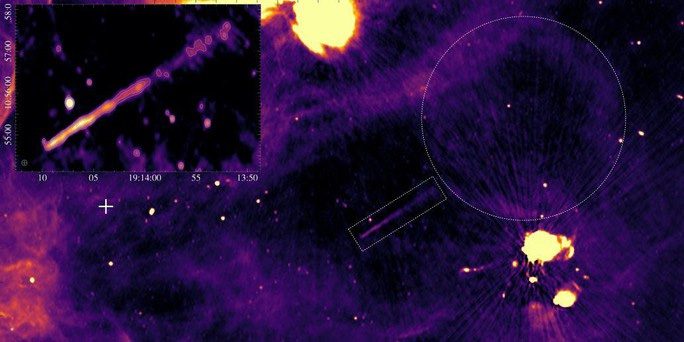In the process of researching black holes, European scientists have discovered a more terrifying and rare object: a dead star transforming into a runaway pulsar.
According to Science Alert, this “ghost” was born from a supernova, which is the explosion of a dead star. However, for PSR J1914+1054g, death is not the end.
After the explosive death, a strange object escaped from the supernova, darting away like a fugitive, leaving behind a long trail of radio emissions reminiscent of a comet’s tail.
This is a high-velocity radio pulsar moving swiftly through space. Before this enigmatic object, only three similar entities had been known.

Strange light trail reveals a “ghost star” as the remnant of an exploded star – (Image: Motta et al., arXiv).
According to the research team led by astrophysicist Sara Elisa Motta from the Brera Astronomical Observatory (Italy) and the University of Oxford (UK), the object emitted by the mysterious supernova, named nebula “Mouse” , represents a newly formed super-dense neutron star.
A neutron star is primarily a pulsar—used to describe luminous objects that appear star-like from our perspective but are not stars. A pulsar can be a neutron star or a black hole actively consuming material.
A neutron star is the remnant of a massive star that has died. It typically remains stationary, rarely fleeing like the one just discovered, shining like a lighthouse as beams of radiation are emitted from its poles, accelerated by an extremely strong magnetic field.
The newly discovered neutron star is believed to be a pulsar, a type of neutron star with intense activity.
The research team suggests that the uneven development of the supernova created a strong kick in the form of a shock wave, disrupting the pulsar’s wind and propelling it from its original position. This stellar wind carries immense energy, forming the glowing tail visible in radio images.
Dr. Motta and her colleagues stumbled upon this ghostly star while using the MeetKAT radio telescope located in South Africa to study a pair known as GRS 1915+105, which consists of a star and a black hole.
However, during their observations, they noticed a strange light streak cutting across the sky, extending 40 light-years, seemingly emanating from a nebula named “Mouse”, which was discovered in 1987. The study also revealed a faint circular shape behind the light streak, identified as the Little Mouse supernova.
The research has been published online on arXiv and has been approved for publication in the next issue of the scientific journal Monthly Notices of the Royal Astronomical Society.




















































